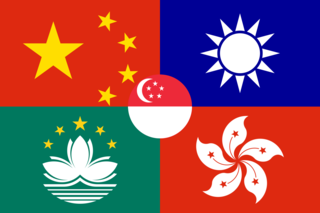Chinese (Mandarin)/About Chinese
About Chinese
[edit | edit source]The Chinese language (汉语/漢語, 华语/華語 or 中文; Pinyin: Hanyu, Huayu, Zhongwen) is a member of the Sino-Tibetan family of languages. About one-fifth of the world speaks some form of Chinese as its native language, making it the most common natively-spoken language in the world.
There is great internal variety within Chinese, and spoken Chinese languages such as Standard Mandarin (Putonghua), Shanghainese (Wu), and Cantonese, which are not mutually intelligible. Nevertheless, there is a single standardized form of Chinese known as Standard Mandarin, which is based on the dialect of Beijing, which is in turn its own Mandarin dialect, among a large and diverse group of Chinese dialects spoken in Northern and Southwestern China. Standard Mandarin is the official language of Mainland China and Taiwan, one of four official languages of Singapore, and one of six official languages of the United Nations. Standard Mandarin also corresponds to the modern standard written Chinese language used by people speaking all forms of Chinese from all corners of China, including Mandarin, Wu, Cantonese, Hakka, Min-nan, and so forth. This textbook will teach Standard Mandarin, both spoken and written.
Chinese grammar is in many ways simpler than European languages (for example, you will see no tenses, plurals, or subject-verb agreement), but there are also plenty of pitfalls that will trip up the unsuspecting beginner (for example, you will encounter tones, measure words, and discourse particles, which do not feature as strongly in European languages). In addition, the complexity of the writing system often daunts newcomers, as Chinese is one of the few languages in the world that does not use an alphabet or a syllabary; instead, thousands of characters are used, each representing a word or a part of a word. However, most complex Chinese characters are composed of only a few hundred simpler characters and many contain phonetic hints. There is a common Western misconception of Chinese writing as having thousands of distinct and idiomatic symbols each representing a single word. However, Chinese writing is surprisingly mnemonic, granted it is not as simple as the writing of Romance languages. The government of China has developed a system of writing Standard Mandarin pronunciation in the Roman alphabet, known as Hanyu Pinyin, or simply, pinyin (汉语拼音/漢語拼音, "spelling according to sounds"). Hanyu Pinyin is used to write out Chinese words phonetically in an effort to help learners of Chinese with their pronunciation. This wikibook will teach you Hanyu Pinyin first, before any actual sentences. All examples and new vocabulary will always be given together with Hanyu Pinyin.
There are two character sets: Simplified Chinese characters (简体字/簡體字, Pinyin: Jiǎntǐzì) and Traditional Chinese characters (繁体字/繁體字, Pinyin: Fántǐzì). Traditional characters trace their lineage through thousands of years of Chinese history, and continue to be used in Hong Kong, Macau, Republic of China, and among many overseas Chinese. Simplified Chinese characters were the result of reforms carried out in Mainland China to increase literacy rates and is now used in Singapore as well. Many people may think that Simplified Chinese was made by the PRC government, but in fact many characters in Simplified Chinese were assembled from the calligraphy in ancient China. There is no denying however that some characters were made up recently. Two systems share many of the same characters or with systematic, predictable reductions in stroke; however, some changes are not as formulaic. As a result, most native Chinese speakers are able to write in only one of the two systems, though they can usually read both. You are recommended to do the same. It is considered easier for people who learn Traditional to read both sets than people who learn Simplified only, but Simplified characters are less intimidating for beginners. In this wikibook, all examples and vocabulary are given in both systems, and you are encouraged to choose one system and stick with it throughout.
Chinese characters have also been used in the past by other neighbouring Asian countries, and are still being used by some of them today. Some older Koreans still know how to read and write Chinese characters, but although the members of younger generations are taught Chinese characters or hanja, they are rarely used and unnecessary for literacy in Korean, with the native alphabet, hangul. Chinese characters are occasionally used for abbreviations, to clarify technical vocabulary (as Chinese serves roughly the same role in Korean that Latin serves in English), and to write family and many personal names. The Japanese still preserve many Chinese characters or kanji today and use them along with two syllabaries to write the Japanese language.









